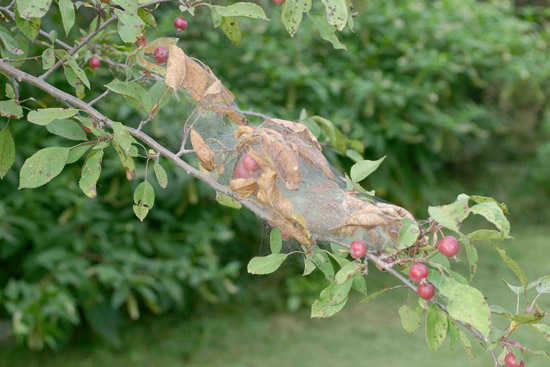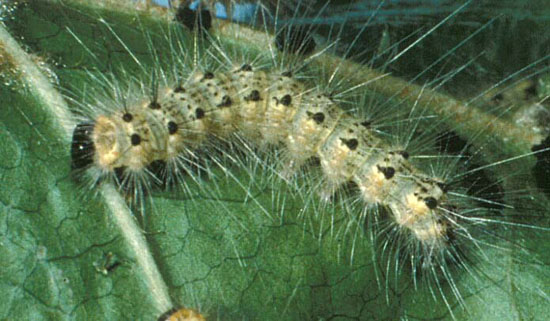Issue 8, June 23, 2014
Fall Webworm
Fall webworm is named for infestations that occur in the northern part of the United States only in late summer to early fall. In the southern half of the United States, including the southern half of Illinois, fall webworm has an additional generation in early summer. This first generation of fall webworm is now feeding in southern Illinois.
Fall webworm overwinters in the pupal stage, emerging as white moths with a 1-1/2-inch wingspan. After mating, moths lay their eggs in large clusters on the leaves of the host. The hatching caterpillars live colonially, spinning a silk tent over leaves at the ends of a branch. Once the caterpillars have eaten the leaves within the silk tent, they increase the size of the tent to enclose more leaves.
This insect has a wide host range, being found on many deciduous trees, including maples, crabapple, black cherry, walnut, pecan, and hickories. There are two races of caterpillars. The black-headed race has a black head, black spots, and frequently a wide black stripe running down the back of a hairy, yellowish body. The red-headed race has a red head but almost no black markings. There does not appear to be any difference in host selection between the two races. When fully grown, the larvae crawl to debris below the tree, where pupation occurs.
Damage from fall webworm can be obvious, with their very noticeable white silk webs. In heavy infestations, entire trees may be defoliated by multiple colonies per tree. However, damage occurs in the second half of the growing season even where there are two generations per year. As a result, damage to tree health is minimal and stripped branches survive to refoliate later in the season or the following spring.

Fall webworm damage to crabapple.
Because the larvae are present within the silk webbing day and night, an effective method of control on smaller trees is physical removal. The webs can be pruned or pulled off and the contained caterpillars smashed. Pulling off the webbing has the advantage of leaving the branch on the tree to releaf.

Fall webworm larva.
The silk tents, or webbing, are an effective deterrent to parasitic wasps, parasitic flies, and insectivorous birds that would attack the caterpillars. Tents also repel rainfall, which also means resistance to insecticide sprays. Insecticide sprays must be applied with enough pressure to penetrate the webbing. If the insecticide does not penetrate the webbing, it may break down on exposed leaves before the caterpillars incorporate them into the expanding tent. Bacillus thuringiensis kurstaki (Dipel, Thuricide), spinosad (Conserve), carbaryl (Sevin), and various pyrethroid insecticides are effective against these caterpillars. (Phil Nixon)
Author:
Phil Nixon